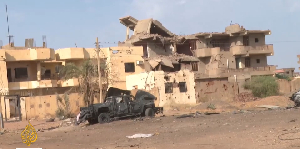The 2014 District League Table (DLT) released by the Centre for Democratic Governance (CDD) ranked the La-Nkwantanang Madina Municipal (LNMM) the second best district with 76.4 per cent.
The DLT initiated by CDD and United Nations International Children's Emergency Fund (UNICEF) in collaboration with the Ministry of Local Government and Rural Development (MLGRD) has been designed to increase social accountability for development across the country’s 216 districts, while improving responsiveness in service delivery.
It is a simple tool that ranks the level of development in each of the districts with aggregate development indicators in six key sectors, namely health, education, sanitation, water, security and governance.
Badu Nkansa Street
The accolade received by LNMM was commended by most inhabitants in the municipality during an interaction with them on the key sectors used to adjudge the municipality.
The residents of Badu Nkansa Street (BNS) near the Madina Police Station, however, expressed their reservation on the success chalked by the municipality with specific reference to health and sanitation.
They expressed worry about the bad road network in the municipality, resulting in dust invading their homes, shops and places of worship.
The road, one of the busiest in the municipality apart from Madina high way and the Alhaji Seidu Street that links the Madina Zongo Junction to the Police Station, has 24-hour pressure from intense traffic from motorists but has not seen any major rehabilitation in the past two years.
Residents reactions
“How can we be suffering from this dusty environment for the past two years and yet have our municipality ranked second, out of 256 nationwide, that is unfortunate!
“Customers fight with me every day because of dusty clothes they collect from my shop, having brought clean materials to be sewn,” a tailor, Mr Yaw Antwi said.
A section of the youth have threatened to block the road after the festive season, if the assembly did not sit up.
The leader of the group, who did not want to be named, said the assembly should at least engage in the daily sprinkling of water on the road to minimise dust, if the officers really shared the concerns of residents.
“The only language that will draw their attention to our plight is to block the road as it was done at Ashaiman some years ago, “he said.
“After attending church or visiting the mosque for prayers in this vicinity, your white dress turns brown due to the dusty environment, “a resident added.
Response from the municipality
For his part, the assembly member of Tantana Electoral Area, Mr Abdul-Aziz Yakubu said about 50 stores had closed down as a result of the dust.
He explained that his outfit had written numerous letters to the municipal assembly hoping for positive results, but they had had no response.
“In his sectional address, the Municipal Chief Executive (MCE) assured us of filling some roads, with the Badu Nkansa road being part of the plans, we are hoping he fulfills his promise because the complains are too many,” he said.
Food vendors, Mr Yakubu said had their profit margins reduced because people did not patronise their food because of the dust.
Apart from the health implications, the dusty environment made life unbearable to residents.
In addition, the MCE of LNMM, Mr Franklin P Anku, attributed the dilapidated nature of the road to inadequate funds.
The municipality, Mr Anku said, was working to address its challenges pertaining roads, adding that “Badu Nkansa Street will be worked on.”
The World Health Organisation’s report on hazard prevention and control in the work environment, air-borne dust, published in 1999 states:
“Whenever people inhale airborne dust at work, they are at risk of occupational disease. Year after year, both in developed and developing countries, overexposure to dusts causes disease, temporary and permanent disabilities and deaths. Dusts in the workplace may also contaminate or reduce the quality of products, be the cause of fire and explosion, and damage the environment.”
Airborne dusts are of particular concern because they are associated with classical widespread occupational lung diseases such as the lung diseases, as well as with systemic intoxications such as lead poisoning, especially at higher levels of exposure. There is also increasing interest in other dust-related diseases, such as cancer, asthma, allergic alveoli is and irritation, as well as a whole range of non-respiratory illnesses, which may occur at much lower exposure levels.
Opinions of Monday, 4 January 2016
Columnist: Yakubu Abdul-Jalil


















